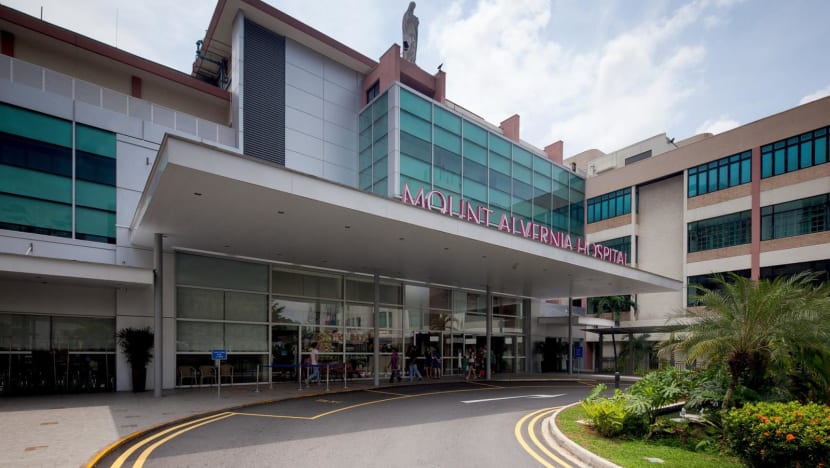New not-for-profit hospital model can increase options for lower-cost private healthcare
The new private hospital model introduced last month is meant to provide more options for people in Singapore who wish to seek care in the private healthcare sector, the Ministry of Health previously said.

Mount Alvernia Hospital is the only private, not-for-profit hospital in Singapore. (Photo: Facebook/Mount Alvernia Hospital)

This audio is generated by an AI tool.
SINGAPORE: A new not-for-profit private acute hospital model introduced last month can increase options for lower-cost private healthcare to better complement public healthcare, Health Minister Ong Ye Kung said on Monday (Feb 5).
Mr Ong was responding to a parliamentary question filed by Member of Parliament Dr Tan Wu Meng (PAP-Jurong) on the existing not-for-profit private acute hospital model in Singapore in comparison to those in other advanced economies, as well as whether additional diversity in acute hospital models will complement the country’s existing care landscape.
Dr Tan also asked about the factors that may constrain the viability of entrants to the new industry locally and how these can be mitigated.
The Ministry of Health (MOH) said on Jan 8 that acute hospital bed capacity needs to be increased in both the public and private healthcare sectors amid increasing demand for healthcare services due to Singapore’s ageing population.
“The new not-for-profit private acute hospital model is meant to provide more options for Singaporeans who wish to seek care in the private healthcare sector,” MOH said then.
The Health Ministry also invited private healthcare operators to participate in an industry consultation for the new model, which will run until April.
During parliament on Monday, Mr Ong noted that the public healthcare system is complemented by a private healthcare system, where there is a range of hospitals.
“Most are quite high in cost, and you need to … either be able to afford or be well-insured to access them, with little or no wait time,” he said.
Mr Ong added that there are a few private hospitals that are lower in cost, such as Mount Alvernia Hospital - Singapore’s only private, not-for-profit hospital.
“MOH’s view is that we can increase options for lower-cost private hospitals so that private healthcare better complements public healthcare and we have a more adequate range of options for Singaporeans.”
The Ministry of Health (MOH) is consulting the healthcare industry to establish a next private hospital, said Health Minister Ong Ye Kung. Replying to an MP’s questions in Parliament on Monday (Feb 5), he said much attention has been given to the proposed not-for-profit feature, but that is not the key feature. Instead, the more important features are serving primarily Singaporeans, stronger governance and cost-effective care. Mr Ong said the Government wants to establish a new private hospital model with these key features to provide a better range of options in the healthcare landscape. MOH believes it can increase the options for lower-cost private hospitals so that private healthcare better complements public healthcare and provides a more adequate range of options for Singaporeans. He said Singapore is better off with a “variegated” system. Mr Ong said MOH has received good responses from professionals and industry. He added that he is sure that it will receive many useful inputs and suggestions on how Singapore can improve and refine its model and “make it a success”.
FEATURES OF NEXT PRIVATE HOSPITAL
Mr Ong also pointed out that hospitals may run as not-for-profit organisations as it is “more in line” with the institutions’ public health mission, and it helps them access philanthropic funds.
“Apart from that, there are no major inherent differences in the way good for-profit and not-for-profit hospitals are run, in terms of quality of care, attention to value-based care, talent recruitment and development,” he said.
Noting that MOH is consulting the industry to establish a next private hospital, Mr Ong added that the proposed not-for-profit aspect is “not the key feature”.
He said that the “more important features” are that the hospital is required to serve primarily Singaporeans.
There will also be stronger governance, whereby the hospital will only have one healthcare license.
This means that the hospital operator needs to have strong oversight and control of its doctors’ clinical practices, said Mr Ong.
The various professionals in that hospital - specialists, surgeons, general physicians, pharmacists, rehabilitation professionals - will have to work closely as a team to serve patients.
For cost-effective care, Mr Ong said: “We intend to impose bill size restrictions on the private hospital as we do not want a high-cost care model.”
“We intend to specify all these as conditions that potential hospital operators who are bidding will have to meet and will be evaluated on,” he added.
This means that land price “will not be the sole (criterion) in determining the hospital operator”, Mr Ong highlighted.
Establishing a new private hospital model with these features provides a better range of options in Singapore’s healthcare landscape, he said.
“Today, we have public healthcare which is heavily subsidised by the government, and which we are trying to make as affordable to Singaporeans as possible.
“But the nature of subsidised care is that there is a wait time, which can be quite lengthy for non-urgent electives.”
“BETTER OFF” WITH VARIED SYSTEM
On Monday, the Health Minister noted a shift in the share between public and private hospital workload, with the ratio moving towards public hospitals.
“This is good in a sense that it is a demonstration of the public’s confidence in public hospitals, but it is not so positive because it adds considerable load to the public healthcare system,” Mr Ong said.
“We are better off with a variegated system, where residents who are well-insured with private policies, have less need for subsidies, can opt for a lower-cost private hospital care if they wish to.”
He added that private hospitals will also bring new insights and ideas to the management and delivery of healthcare, and the additional diversity will enrich and improve the quality of Singapore’s healthcare system.
On Dr Tan’s question about constraints on the new model, Mr Ong said: “I prefer not to make any pre-judgements on the constraints or success factors that the member asked for on this new private hospital model.”
In a supplementary question, Dr Tan asked why there has not been a second Mount Alvernia Hospital or a similar model in Singapore so far if such models of care are already viable and have an existing market niche.
In response, Mr Ong said that Singapore has been expanding its public healthcare and hospitals and that there is a need for manpower, which takes time to develop.
“The resource, in terms of manpower and talent … is limited. If we over push this, we can end up having a bidding war of our healthcare professionals and talent, which is why we are always careful as we develop our healthcare capacity.”
Having said that, Singapore is developing and building more public hospitals between now and the end of the decade, Mr Ong noted.
“But in addition, we think we can, we should be able to accommodate one more, more affordable private hospital,” he added.
















